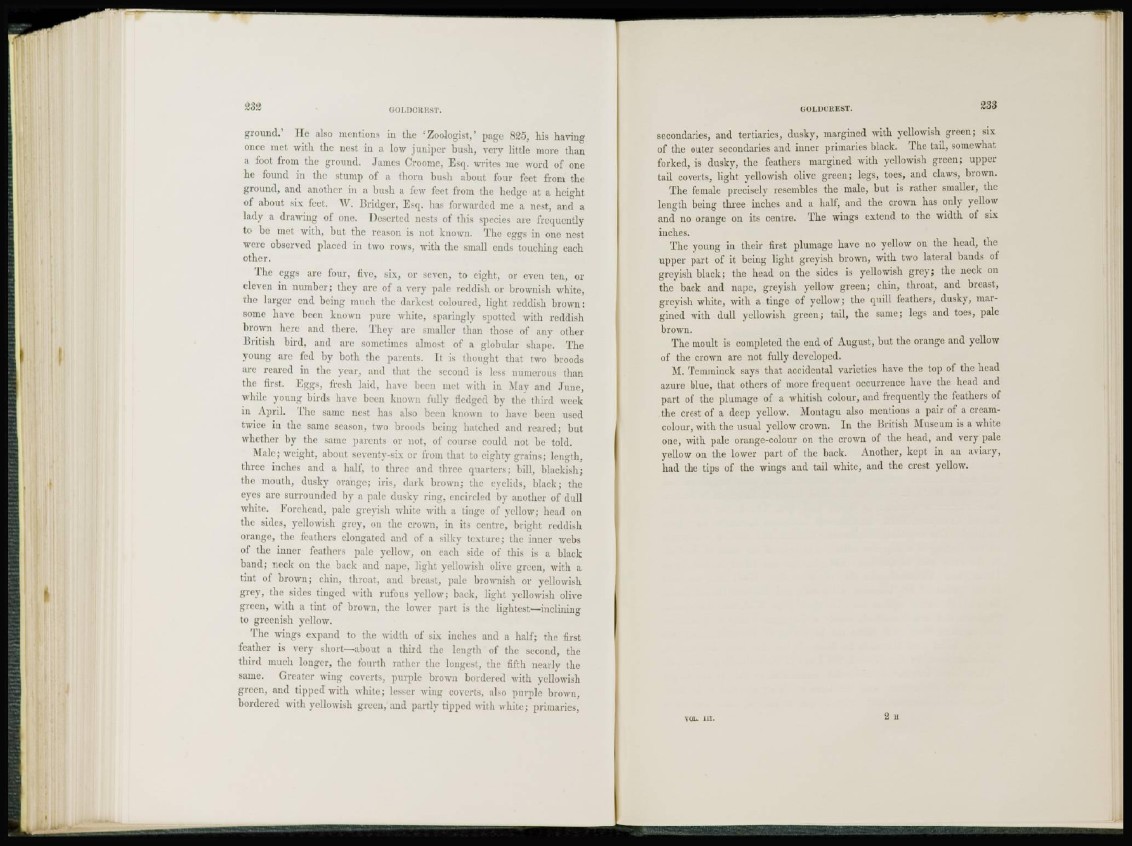
GOLDCK EST.
ground.' He also mentions in the 'Zoologist,' page H25, his having
once met with the nest in a low juniper bush, very little more than
a foot from the ground. James Croomc, Esq. writes me word of one
he found in the stump of a thorn bush about four feet from the
ground, and another in a bush a few feet from the hedge at a height
of about six feet. W. Bridger, Esq. has forwarded me a nest, and a
lady a drawing of one. Deserted nests of this species arc frequently
to be met with, but the reason is not known. The eggs in one nest
were observed placed in two rows, with the small ends touching each
other.
The eggs arc four, five, six, or seven, to eight, or even ten, or
eleven in number; they arc of a very pale reddish or brownish white,
the larger end being much the darkest coloured, light reddish brown:
some have been known pure white, sparingly spotted with reddish
brown here and there. They are smaller than those of any other
British bird, and are sometimes almost of a globular shape. The
young are fed by both the parents. It is thought that two broods
are reared in the year, and that the second is less numerous than
the first. Eggs, fresh laid, have been met with in Mav and June,
while young birds have been known fully Hedged by the third week
in April. The same nest has also been known to have been used
twice in the same season, two broods being hatched and reared; but
whether by the same parents or not, of course could not be told.
Male; weight, about seventy-six or from that to eighty grains; length,
three inches and a halt', to three1 and three quarters; bill, blackish;
the mouth, dusky orange; iris, dark brown; the eyelids, black; the
eyes arc surrounded by a pale dusky ring, encircled by another of dull
white. Forehead, pale greyish white with a tinge of yellow; head on
the sides, yellowish grey, on the crown, in its centre, bright reddish
orange, the feathers elongated and of a silky texture; the inner webs
of the inner feathers pale yellow, on each side of this is a black
band; neck on the back and nape, light yellowish olive green, with a
tint of brown; chin, throat, and breast, pale brownish or yellowish
grey, the sides tinged with rufous yellow; back, light yellowish olive
green, with a tint of brown, the lower part is the lightest—inclining
to greenish yellow.
The wings expand to the width of six inches and a half; the first
feather is very short—about a third the length of the second, the
t h i rd much longer, the fourth rather the longest, the fifth nearly the
same. Greater wing coverts, purple brown bordered with yellowish
green, and tipped with white; lesser wing coverts, also purple brown,
bordered with yellowish green, and partly tipped with white; primaries,
OOLDCltEST. 233
secondaries, and tertiarics, dusky, margined with yellowish green; six
of the outer secondaries and inner primaries black. The tail, somewhat
forked, is dusky, the feathers margined with yellowish green; upper
tail coverts, light yellowish olive green; legs, toes, and claws, brown.
The female precisely resembles the male, but is rather smaller, the
length being three inches and a half, and the crown has only yellow
and no orange on its centre. The wings extend to the width of six
inches.
The young in their first plumage have no yellow on the head, the
upper part of it being light greyish brown, with two lateral bands of
greyish black; the head on the sides is yellowish grey; the neck on
the back and nape, greyish yellow green; chin, throat, and breast,
greyish white, with a tinge of yellow; the quill feathers, dusky, margined
with dull yellowish green; tail, the same; legs and toes, pale
brown.
The moult is completed the end of August, but the orange and yellow
of the crown are not fully developed.
M. Temmiuck says that accidental varieties have the top of the head
azure blue, that others of more frequent occurrence have the head and
part of the plumage of a whitish colour, and frequently the feathers of
the crest of a deep yellow. Montagu also mentions a pair of a creamcolour,
with the usual yellow crown. In the British Museum is a white
one, with pale orange-colour on the crown of the head, and very pale
yellow on the lower part of the back. Another, kept in an aviary,
had the tips of the wings and tail white, and the crest yeUow.
VOL. in.